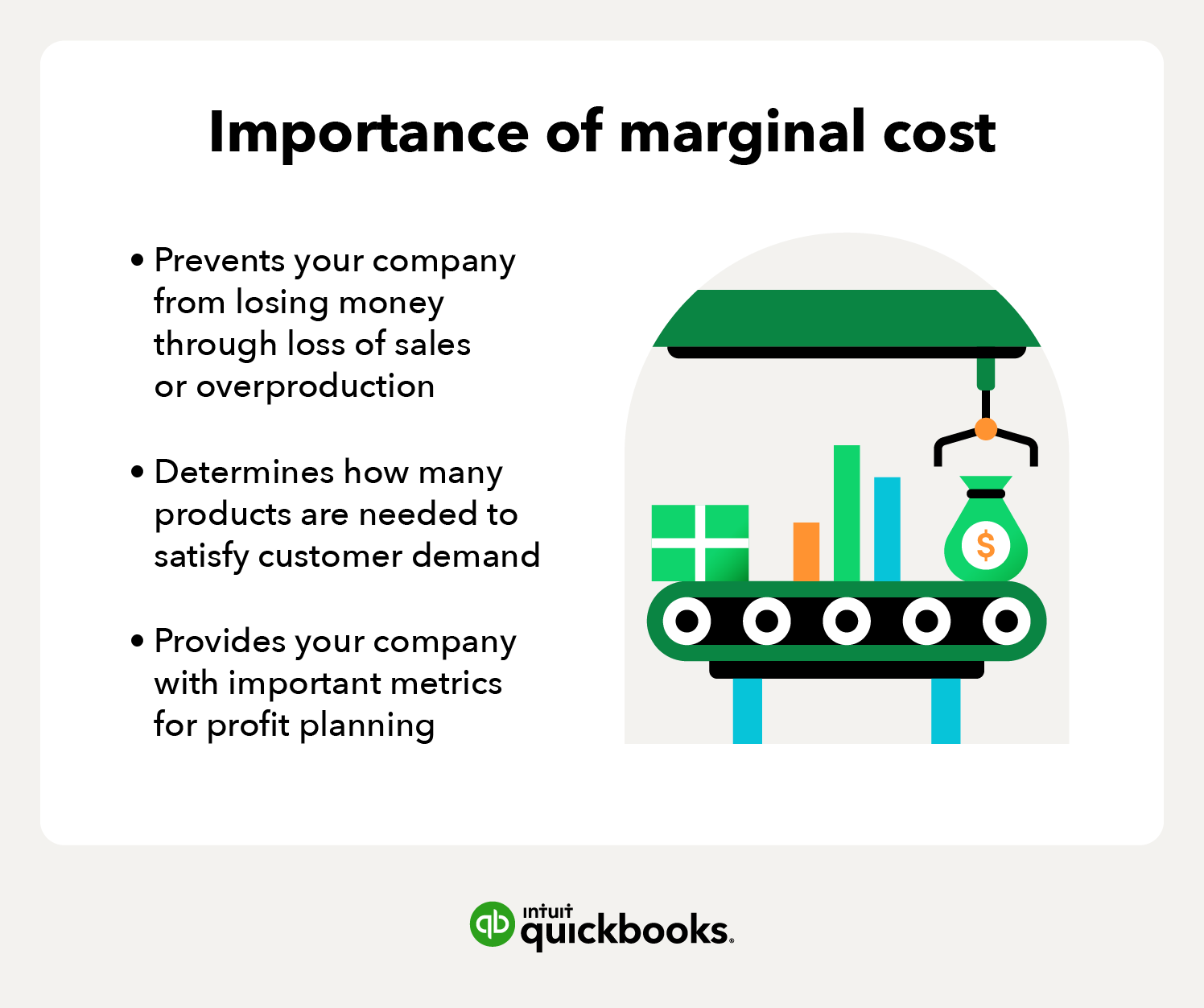
How to calculate marginal cost: With examples
Key Takeaways
Does producing just one more product or offering an additional service actually improve your bottom line, or could it end up costing more than it’s worth?
This is where marginal cost becomes essential — it helps businesses assess the financial impact of increasing output.
By analyzing marginal cost, companies can set production levels and prices that cover expenses while still driving profits. This tool allows businesses to adapt their operations, maintain efficiency, and protect their profit margins.
Strategic applications of marginal cost in business operations
Marginal cost is a metric for making strategic decisions. It measures the cost difference between producing the current output and adding one more unit, helping companies determine when to increase production and when it’s more profitable to hold back.
For example, in early production stages, economies of scale may reduce the average cost of additional units. But overproduction can lead to diminishing returns, with marginal costs rising as businesses need to invest in more labor, machinery, or other resources.
Beyond production, marginal cost is useful in pricing decisions — especially for special orders or custom deals — ensuring that businesses set prices that support profitability.
Marginal cost isn’t just an abstract concept — it’s a practical tool that businesses of all sizes can apply.
In this guide, we’ll explore how to calculate marginal cost, examine real-world examples, and provide actionable insights on using marginal cost to drive business success.
How to calculate marginal cost
At its core, marginal cost helps businesses understand how much it will cost to produce one more unit of a product or service. This insight is essential for decision-making around production, pricing, and profitability.
Here’s how to calculate marginal cost effectively, using a simple formula:
Marginal cost = (Change in total cost) / (Change in quantity)
Let’s break this down:
- Change in total cost: This refers to the difference in total costs before and after production is increased. Total costs include both fixed costs (such as rent and equipment, which remain constant) and variable costs (like raw materials and labor, which change with production volume).
- Change in quantity: This is the difference between the initial and final number of units produced.
Example calculation:
Imagine a bakery produces 100 cakes for a total cost of $1,000. If producing 101 cakes raises total costs to $1,015, the marginal cost of producing the 101st cake would be:
($1,015 - $1,000) / (101 - 100) = $15
This calculation shows that each additional cake costs $15 to produce. Businesses can use this information to determine whether the price they charge for each extra unit will be profitable or not.
Fixed vs. variable costs in marginal cost
It’s important to understand the role of fixed and variable costs when calculating marginal cost. Fixed costs — like factory rent — don’t change with production, meaning they become more efficient as output increases.
In contrast, variable costs — such as raw materials — rise with every additional unit. Businesses need to monitor both types to maintain profitability as they scale production.
Let’s say a clothing manufacturer incurs fixed costs of $5,000 per month for rent and equipment. Producing the first 500 T-shirts costs $3 per shirt in labor and materials, but beyond 500 shirts, overtime pay for workers raises the variable cost to $4 per shirt. If marginal costs begin to exceed the revenue generated by each shirt, the manufacturer knows it’s time to reconsider production plans.
Why marginal cost matters
Calculating marginal cost helps businesses make informed production decisions. For instance, if the marginal cost to produce one more unit is lower than the unit’s selling price, it makes sense to increase production. On the other hand, if marginal costs rise above the revenue per unit, scaling production could harm profitability.

Marginal cost, average cost, and revenue dynamics
Earlier, we covered how marginal cost captures the expense of producing one more unit. Now, let’s explore how marginal cost interacts with average cost and marginal revenue, helping businesses stay efficient and profitable.
Marginal cost vs. average cost
Marginal cost offers insight into the price of increasing production, while average cost shows the total cost distributed across all units produced. When marginal cost is lower than average cost, producing more helps lower the average cost per unit, giving businesses more bang for their buck. However, once marginal cost starts to rise above average cost, it’s a signal to cut your losses — pushing production further may not be worth the extra expense.
This interaction creates the familiar U-shaped curve: costs initially decline with increased production but begin to climb as capacity is stretched. Identifying the sweet spot where average costs are minimized helps businesses stay lean and efficient.
The role of marginal revenue
While marginal cost reflects production costs, marginal revenue measures the income from selling one more unit. The goal is to skate where the puck is going — producing just enough to match marginal cost with marginal revenue. This ensures every additional unit contributes positively to the bottom line.
For example, if a bakery’s marginal cost per cupcake is $1.50 but each cupcake sells for $2.00, production should continue to ramp up. However, if overtime wages push the marginal cost to $2.50, the bakery needs to rethink its strategy to avoid losses and ensure proper returns.
How these concepts optimize business operations
Balancing marginal cost, average cost, and marginal revenue helps businesses maximize profits. Producing only as long as marginal revenue exceeds marginal cost ensures resources are well used and profits remain strong.
Knowing when to cut your losses and scale back production prevents unnecessary expenses and allows you to focus on what delivers the most value. This kind of foresight keeps businesses agile and ahead of the game.
Real-world applications of marginal cost
Marginal cost plays a crucial role in helping businesses make informed decisions across various industries. Whether it’s manufacturing, retail, or services, companies use marginal cost analysis to manage production, pricing, and special orders.
Let's explore a few practical applications to show how this concept drives smart decision-making.
Pricing strategies
Companies often rely on marginal cost to develop competitive pricing models.
For example, if the marginal cost to produce a product is $10, pricing it just above that — say at $15 — ensures that production costs are covered and some profit is earned to help offset fixed costs like rent or salaries.
Retailers may also use marginal cost to offer discounts during clearance sales. If the marginal cost remains low, selling excess inventory at a reduced price still generates a net gain, even if the price is lower than usual.
Managing production and capacity
Businesses must consider marginal cost to avoid overextending their resources. A factory that operates efficiently at 80% capacity might run into higher costs if pushed beyond that level due to overtime wages or machine maintenance. So companies need to know when to pull the chute — adjusting production before marginal costs climb too high and erode profits.
Understanding marginal cost dynamics allows managers to set optimal production limits without wasting resources.
Special orders and bulk deals
Service industries, like hospitality or event planning, often use marginal cost to decide whether to accept special pricing deals.
For example, a hotel might accept a bulk booking at a discount, knowing that the marginal cost of additional guests (such as housekeeping and amenities) remains low. Even if the rate is lower than usual, the deal contributes positively as long as the marginal cost stays below the income generated.
This principle also applies to manufacturing, where businesses can take on custom orders as long as they don’t exceed production capacity and trigger steep marginal costs.
Cost-benefit analysis and resource allocation
Governments and organizations also apply marginal cost in cost-benefit analyses. For example, public transportation providers might assess the marginal cost of adding another bus to a route. If the additional service draws enough passengers to justify the expense, it makes financial sense. But if the new service barely covers costs, it may be better to allocate resources elsewhere.
By incorporating marginal cost into decision-making processes, businesses can optimize production, pricing, and resource allocation. Whether offering bulk discounts or managing factory capacity, staying on top of marginal cost helps companies remain agile and competitive.
Key takeaways for business owners
Marginal cost is more than just a number — it’s a tool that helps businesses make smart decisions about production, pricing, and efficiency.
Here are practical ways to integrate marginal cost analysis into your operations without getting bogged down in unnecessary complexity:
1. Focus on profitable production
Using marginal cost allows you to spot the right time to scale up or slow down. Instead of maximizing output blindly, focus on producing only as long as the additional unit costs less than what it brings in. This approach prevents resource waste and keeps production lean.
2. Price products to cover both fixed and variable costs
Beyond covering production costs, effective pricing must also contribute to fixed costs like rent and salaries. Marginal cost analysis helps set minimum price points for products, ensuring every sale adds to the business's financial health. For bulk orders or discounts, it’s essential to check that reduced prices still exceed marginal costs to keep deals profitable.
3. Take on special orders with purpose
Before committing to custom or discounted orders, marginal cost helps you decide whether those deals will truly benefit the business. If a deal covers the marginal cost, it’s a chance to unlock value without extra strain on resources — making these orders a great way to boost cash flow without incurring losses.
4. Anticipate cost changes before they affect profits
Rather than reacting to rising costs, businesses can stay ahead by monitoring marginal cost closely. If costs start to climb — due to overtime, materials, or machinery wear, for example — it’s time to adjust production or pricing strategies. Spotting these trends early lets you pivot without scrambling for a fix later.
By incorporating marginal cost analysis into everyday operations, businesses can make decisions that balance growth with sustainability. The key is knowing when to act and when to pull back — like skating where the puck is going, not where it’s been.

Maximize profit with smart cost management
Marginal cost is a powerful tool for businesses of all sizes, helping them fine-tune production, set sustainable prices, and avoid wasteful spending.
By understanding how marginal cost interacts with revenue and total costs, business owners can make data-driven decisions that keep operations profitable.
Whether you're managing a factory, offering services, or handling special orders, staying on top of marginal cost ensures every unit produced contributes to your bottom line.
To streamline expense tracking and keep your business running efficiently, explore how QuickBooks can help. With tools to manage production costs, monitor cash flow, and simplify pricing decisions, QuickBooks Online equips you with everything you need to maintain financial health and grow sustainably.
Frequently asked questions
Disclaimer
Money movement services are provided by Intuit Canada Payments Inc.
This content is for information purposes only and should not be considered legal, accounting or tax advice, or a substitute for obtaining such advice specific to your business. Additional information and exceptions may apply. Applicable laws may vary by region, province, state or locality. No assurance is given that the information is comprehensive in its coverage or that it is suitable in dealing with a customer’s particular situation. Intuit does not have any responsibility for updating or revising any information presented herein. Accordingly, the information provided should not be relied upon as a substitute for independent research. Intuit does not warrant that the material contained herein will continue to be accurate nor that it is completely free of errors when published. Readers should verify statements before relying on them.
We provide third-party links as a convenience and for informational purposes only. Intuit does not endorse or approve these products and services, or the opinions of these corporations or organizations or individuals. Intuit accepts no responsibility for the accuracy, legality, or content on these sites.

